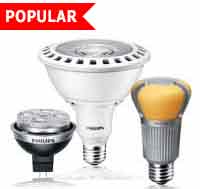LED light bulb price dipped 10% in October
LED light bulb price dipped 10% in October, but market reception is expected to increase.According to the price survey conducted by LEDinside, the LED light bulb prices for 60W incandescent light bulb replacement underwent a drastic drop of 9% in October; the price dropped by 10% in America and hit a low of USD 24.97, with the average selling price (ASP) declining to USD 38.6. The LED light bulb prices for 40W incandescent light bulb replacement were relatively stable.
LED light bulb for 60W replacement saw considerable price drop
LEDinside indicates that in October, LED light bulb prices the United States took the most drastic dip: the prices of LED light bulbs for 40W and 60W replacements dropped 3% and 10%, respectively. At present, the ASP of 60W replacement products dropped to USD 31.3 with the lowest price hitting USD 24.97, a much more consumer-friendly price compared to those of other regions. The prominent price downtrend attributed to the price cutting strategy of Philips, which triggered other brand vendors to lower their prices and in turn caused the prices to drop vastly.
Prices of brand-name LED light bulbs for 40W replacement plunged to USD 11.6
As for 40W incandescent replacement products, the ASP in October remained stable compared with September. Even though the prices in most areas experienced a drop of roughly 3%, the ASP rise in Europe canceled out the overall decline, resulting in the October ASP remained the same as September.
Interestingly, the prices of 40W incandescent replacement products in South Korea remained relatively low. Due to the continuous price cutting of brand vendors, the lowest price hit USD 11.6, approaching the sweet spot of USD 10 which LEDinside previously predicted.
Perspectives
According to LEDinside, due to the persisting price downturn, the ASP of LED light bulbs fell below USD 48 /Klm, getting closer to the expectations of the consumers. As for the market trend, the market acceptance of LED lights has been increasing.
Therefore, several countries are planning to enact subsidy policies to increase the penetration rate of LED light bulbs. Chinese government has imposed the ban against incandescent lights, and is expected to announce the subsidy policies for LED light bulbs at the end of 2011. As for Taiwan, the subsidy policy is still in discussion, which should be finalized as soon as possible in order to catch up with the global trend.
Source for this Article: Electronics Feed

















Comments